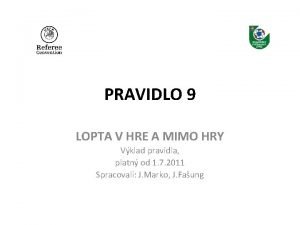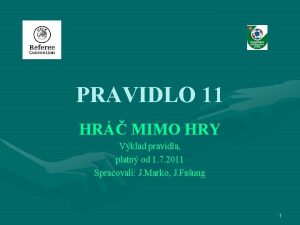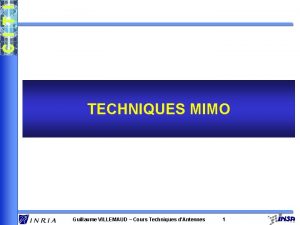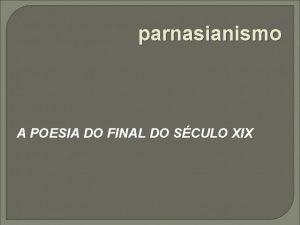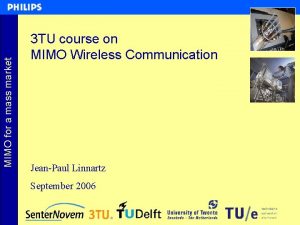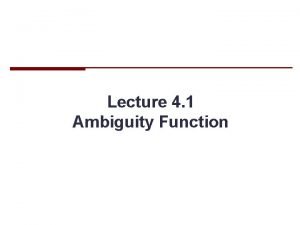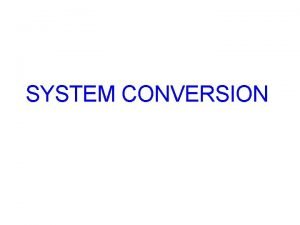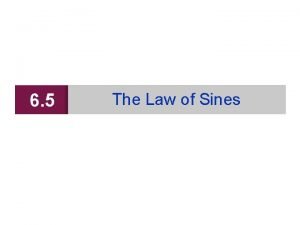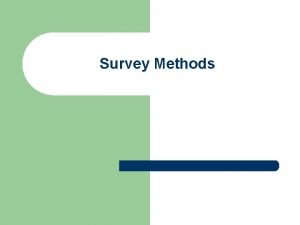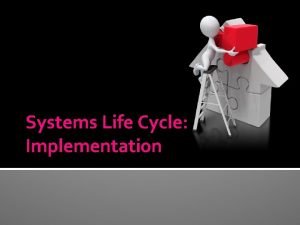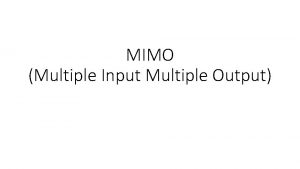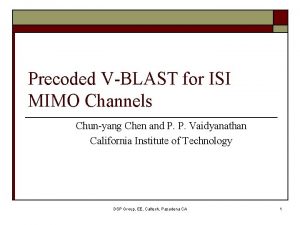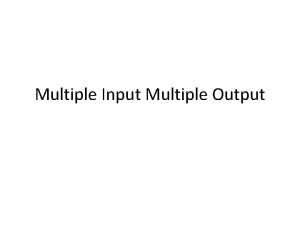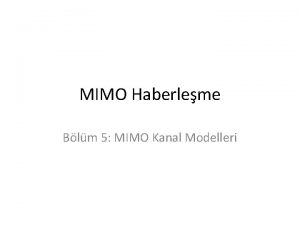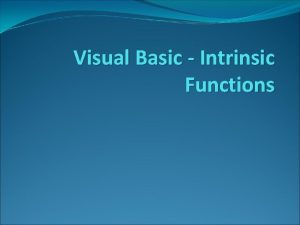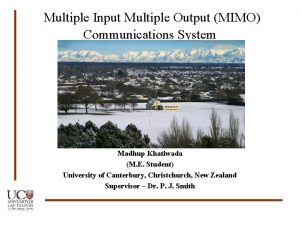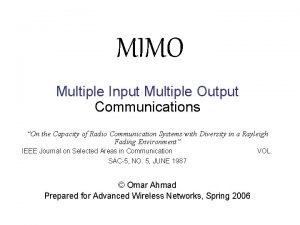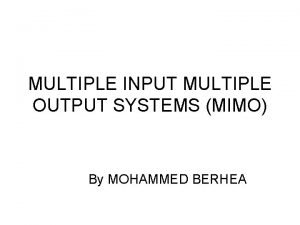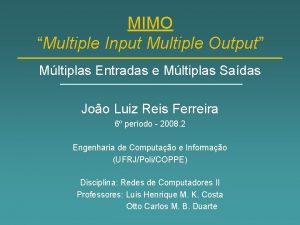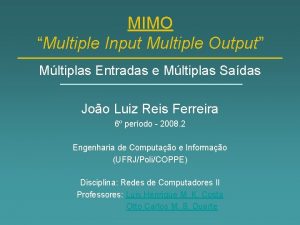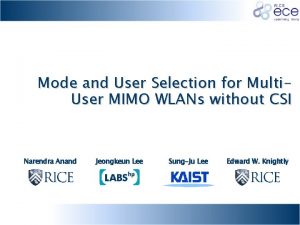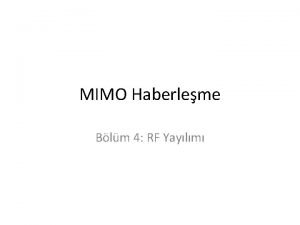Multiple user MIMO with only precoded pilot and






















- Slides: 22

Multiple user MIMO with only precoded pilot and limited feedback for FDD DL Document Number: C 802. 16 m-08/379 Date Submitted: 2008 -05 -05 Source: Dongjun Lee, Jungnam Yun, Rajagopal. S. Iyengar POSDATA Co, Ltd. 276 -2, Seohyeon-dong, Bundang-gu, Seongnam-si, Kyeonggi-do, 463 -775, Korea Jungwoo Lee, School of Electrical Engineering, Seoul National University Korea Email: djthekid@posdata. co. kr Email: junglee@ee. snu. ac. kr Venue: IEEE 802. 16 m-08/005 “Call for Contributions on Project 802. 16 m System Description Document (SDD)”, In response to the following topics: “DL MIMO” Purpose: To be discussed and adopted by TGm for the 802. 16 m SDD. Notice: This document does not represent the agreed views of the IEEE 802. 16 Working Group or any of its subgroups. It represents only the views of the participants listed in the “Source(s)” field above. It is offered as a basis for discussion. It is not binding on the contributor(s), who reserve(s) the right to add, amend or withdraw material contained herein. Release: The contributor grants a free, irrevocable license to the IEEE to incorporate material contained in this contribution, and any modifications thereof, in the creation of an IEEE Standards publication; to copyright in the IEEE’s name any IEEE Standards publication even though it may include portions of this contribution; and at the IEEE’s sole discretion to permit others to reproduce in whole or in part the resulting IEEE Standards publication. The contributor also acknowledges and accepts that this contribution may be made public by IEEE 802. 16. Patent Policy: The contributor is familiar with the IEEE-SA Patent Policy and Procedures: <http: //standards. ieee. org/guides/bylaws/sect 6 -7. html#6> and <http: //standards. ieee. org/guides/opman/sect 6. html#6. 3>. Further information is located at <http: //standards. ieee. org/board/pat-material. html> and <http: //standards. ieee. org/board/pat >. 1

Overview q This contribution presents a new MU-MIMO scheme for FDD DL q In the conventional MU-MIMO for FDD DL, there are disadvantages in 2 aspects. 1. Channel Feedback need too many bits for better performance. Reduced feedback rate leads to great performance loss. 2. Both common pilot and precoded dedicated pilot are needed. Common pilot is used for channel feedback, while precoded dedicated pilot is for MIMO detection. There will be too much DL over head. q We propose a novel MU-MIMO scheme for FDD DL, where only precoded pilot is needed for transmission side. To reduce channel feedback, we combine the channel element scalar quantization, differential channel feedback, and Rx antenna selection which can greatly reduce the feedback bits.

Feedback Strategy for Multiuser MIMO • Codebook approach – Small feedback bits (Codebook) – High complexity • Quantization (scalar) approach – Many feedback bits (Quantization per element) – Cartesian coordinate is desirable. – Low complexity • Scalar quantization is preferred. – Due to the need for precise CSI for MU-MIMO to remove inter-user interferences

Channel Element Based Scalar quantization • Scalar quantization per channel element – Rectangular coordinates • 8 bits • 4 bits for real part • 4 bits for image part – Polar coordinates: total 8 bits • Magnitude bits : 3 bits • Phase bits : 5 bits – Rectangular coordinate Is preferred.

Performance of Channel Element Based Scalar quantization • Scalar quantization per each element – 8 bits per each element (4 bits for real part, 4 bits for image) – 32 bits for 4ⅹ 1 channel matrix

Feedback Reduction Schemes q Pros • Usage of Differential Channel Feedback to reduce UL overhead ü Only Feed back the whole channel matrix at the initial transmission ü In the later transmission, MS only feedbacks 1 -2 bits differential information for each channel element. • Rx antenna selection ü Reduce channel feedback by effective converting a 4 x 2 MIMO channel into a 4 x 1 MIMO channel. ü Reduce feedback rate by factor of 2.

Feedback Reduction for Multiple Rx Antennas • Pros – Reduce the feedback rate by factor of 2 by using channel matrix size from 4 x 2 to 4 x 1 – Increase simultaneously serviced users from 2 to 4: increased multiuser diversity • Cons: – peak DL rate for individual user is halved.

Feedback Reduction for Multiple Rx Antennas • Antenna selection mode – Select one of many Rx antennas

MU-MIMO with Only precoded pilot • Precoded pilots: two approaches – Accumulated precoding – Precoding inversion

Advantage of MU-MIMO with Only precoded pilot q Pros • Reduce DL overhead due to; ü Only Precoded common pilots are needed for both channel feedback and detection ü No need for both precoded and non-precoded pilot q Cons • Performance loss by multi user scheduling based on the precoded pilot this can be further optimized by accumulated precoding and precoding matrix inverse

Accumulated Precoding for MU-MIMO Figure 2. Accumulated precoding for MU-MIMO - In FDD system, following operations can be applied as in Figure 2. - the BS only transmits the precoded dedicate pilot. By this precoded dedicate pilot, MS estimates his precoded channel information and feedback to the BS. Based on all the MS’s precoded CSI information, BS does the scheduling and calculates the corresponding new precoding matrix for the selected MSs. The final precoding matrix is the combination of the calculated new precoding matrix with the previous frame’s precoding matrix—Acumulated precoding.

Accumulated Precoding • Accumulated precoding where – : precoding matrix for user i at frame k

Accumulated Precoding

Accumulated Precoding • Performance degrades when coherence time gets longer – Not good for nomadic or low-mobility users

Power-adjusted Accumulated Precoding • A problem with accumulated precoding – In the scheduling for next frame with , previously selected users is not favored because of 0 in channel element, which reduces the effective channel power • Solution: power-adjusted accumulated precoding – Multiply by 1/2 for non-selected users for channels with coherence time of larger than 1 frame. – Multiplication by ½ needs to be done adaptively depending on the coherence time. – Difficult to implement

Power-adjusted Accumulated Precoding • Power-adjusted accumulated precoding – Select users with

Power-adjusted Accumulated Precoding • Simulation results – It works well but needs to estimate the coherence time, and adapt the algorithm.

Precoding Inversion Scheme for MU-MIMO • Channel estimation at ith user – – – (A) is fed back to the BS

Precoding Inversion Scheme • At the BS – – • We empirically observe that exists through simulations • Therefore we can estimate the raw channel through precoding matrix inversion at the BS

Precoding Inversion Scheme • Simulation results – No need to adapt the algorithm based on coherence time • Precoding inversion is preferred over the accumulated approach due to the adaptation requirement

Summary of Proposals • Quantization is preferred over codebook due to lower search complexity – 8 bits per complex channel matrix elements using rectangular coordinate – # of feedback bits: 32 bits per subcarrier group per frame per user – differential channel feedback can be used to further reduce the overall amount of feedback • Precoded pilots – Precoding inversion is preferred over the accumulated precoding because no adaptation is required for precoding inversion.

Text Recommendations for SDD Section 11 Physical Layer • Section 11. x DL MIMO structure – 11. x. y DL MU-MIMO structure for FDD • DL MU-MIMO with precoded pilot only shall be used for FDD mode to reduce DL overhead • Channel element scalar quantization, differential channel feedback and antenna selection are used so that the UL overhead can be reduced 22
 Single user and multi user operating system
Single user and multi user operating system Operating systems
Operating systems Lopta mimo hry
Lopta mimo hry Postavenie mimo hry
Postavenie mimo hry La mula de memo
La mula de memo Guillaume villemaud
Guillaume villemaud Mimo
Mimo Alberto de oliveira parnasianismo
Alberto de oliveira parnasianismo (mackenzie) não caracteriza a estética parnasiana
(mackenzie) não caracteriza a estética parnasiana Mimo teocrito
Mimo teocrito Mass mimo
Mass mimo Mimo
Mimo Multiple baseline across settings
Multiple baseline across settings Advantages and disadvantages of mimd
Advantages and disadvantages of mimd Take only photos leave only footprints
Take only photos leave only footprints Pilot conversion disadvantages
Pilot conversion disadvantages A pilot sets out from an airport and heads in the direction
A pilot sets out from an airport and heads in the direction Pros and cons of being a pilot
Pros and cons of being a pilot What exception if any permits a private pilot
What exception if any permits a private pilot Md mizanur rahman pilot
Md mizanur rahman pilot Pilot proficiency award program
Pilot proficiency award program Poisonwood bible theme
Poisonwood bible theme Direct changeover and parallel running
Direct changeover and parallel running


